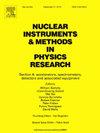重离子束对平行板雪崩计数器 (PPAC) 的速率诱导老化效应
IF 1.5
3区 物理与天体物理
Q3 INSTRUMENTS & INSTRUMENTATION
Nuclear Instruments & Methods in Physics Research Section A-accelerators Spectrometers Detectors and Associated Equipment
Pub Date : 2024-11-19
DOI:10.1016/j.nima.2024.170076
引用次数: 0
摘要
稀有同位素光束设施(FRIB)是利用放射性光束进行核科学研究的主要科学用户设施之一,能够以高达 200 MeV/u 的能量产生从氧气到铀的大多数(约 80%)同位素。随着束流功率从目前的 10 kW 增加到计划的 400 kW,FRIB 实验即将进入一个新时代。在预期的高束流强度(1 MHz)下,需要前所未有的速率能力,以及用于束流诊断和束流调谐的所有计划仪器的稳定性能。本文概述了在用于光束诊断的先进稀有同位素分离器(ARIS)探测器(包括平行板雪崩计数器(PPAC)和用于飞行时间测量的塑料闪烁器)中观察到的高重离子束速率下的老化现象。还介绍了目前为减轻速率引起的老化而开展的研究和开发项目。本文章由计算机程序翻译,如有差异,请以英文原文为准。
Rate-induced aging effects on Parallel-Plate Avalanche Counter (PPAC) caused by heavy ion beams
The Facility for Rare Isotope Beams (FRIB) is one of the premier scientific user facilities for nuclear science with radioactive beams, capable of producing most (approximately 80%) of the isotopes expected to exist, from oxygen to uranium, at energies up to 200 MeV/u. With the increase in beam power from the present 10 kW to the planned 400 kW, FRIB experiments are about to enter a new era. An unprecedented rate capability as well as stable performance of all the planned instrumentation intended for beam diagnostics and beam tuning is required at the expected high beam intensities ( MHz). A summary of aging phenomena at high heavy-ion beam rates observed in the Advanced Rare Isotope Separator (ARIS) detectors for beam diagnostics, including Parallel Plate Avalanche Counters (PPAC) and plastic scintillation for time-of-flight measurements, is discussed. Current research and development project to mitigate rate-induced aging are presented.
求助全文
通过发布文献求助,成功后即可免费获取论文全文。
去求助
来源期刊
CiteScore
3.20
自引率
21.40%
发文量
787
审稿时长
1 months
期刊介绍:
Section A of Nuclear Instruments and Methods in Physics Research publishes papers on design, manufacturing and performance of scientific instruments with an emphasis on large scale facilities. This includes the development of particle accelerators, ion sources, beam transport systems and target arrangements as well as the use of secondary phenomena such as synchrotron radiation and free electron lasers. It also includes all types of instrumentation for the detection and spectrometry of radiations from high energy processes and nuclear decays, as well as instrumentation for experiments at nuclear reactors. Specialized electronics for nuclear and other types of spectrometry as well as computerization of measurements and control systems in this area also find their place in the A section.
Theoretical as well as experimental papers are accepted.

 求助内容:
求助内容: 应助结果提醒方式:
应助结果提醒方式:


